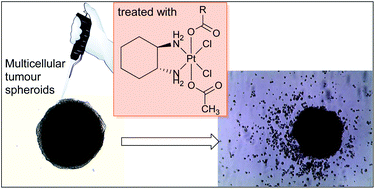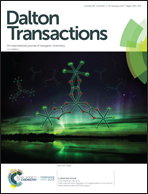Synthesis and characterization of cyclohexane-1R,2R-diamine-based Pt(iv) dicarboxylato anticancer prodrugs: their selective activity against human colon cancer cell lines†
Abstract
Three pairs of asymmetric dicarboxylato derivatives based on the cisplatin and oxaliplatin-like skeletons have been synthesized de novo or re-synthesized. The axial ligands consist of one medium-chain fatty acid (MCFA), namely clofibrate (i.e. 2-(p-chlorophenoxy)-2-methylpropionic acid, CA), heptanoate (HA) or octanoate (OA), respectively, and an inactive acetato ligand that imparts acceptable water solubility to such conjugates. Stability tests provided evidence for the partial formation of two hydrolyzed products, corresponding to two monoaqua diastereomers derived from the substitution of an equatorial chlorido ligand with a water molecule. The complexes have been tested on three different colon cancer cell lines having different histological history, and also on the cisplatin-sensitive A2780 ovarian cancer cell line for comparison. This allowed the evaluation not only of the increase in activity on passing from Pt(II) to Pt(IV) derivatives, but also the selectivity towards colon cancer cells brought about by the cyclohexane-1R,2R-diamine carrier ligand.



 Please wait while we load your content...
Please wait while we load your content...